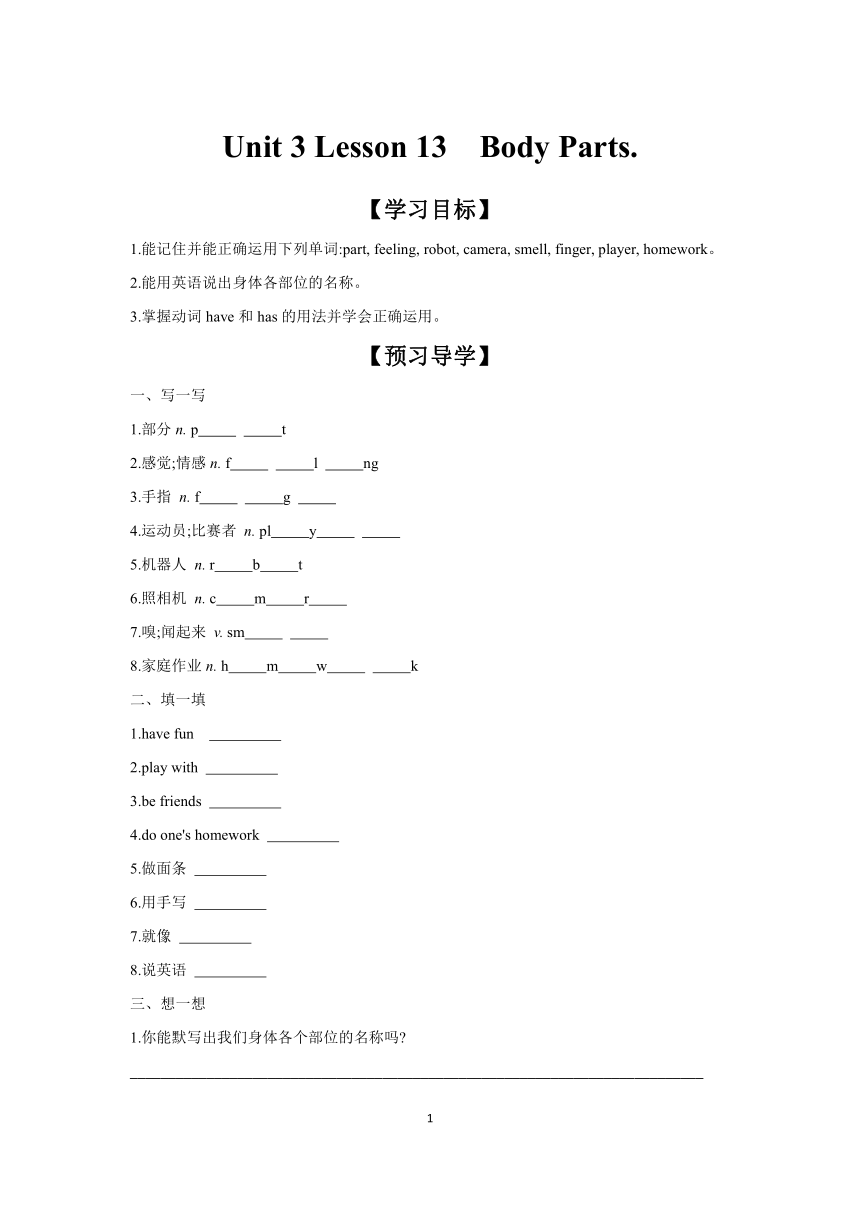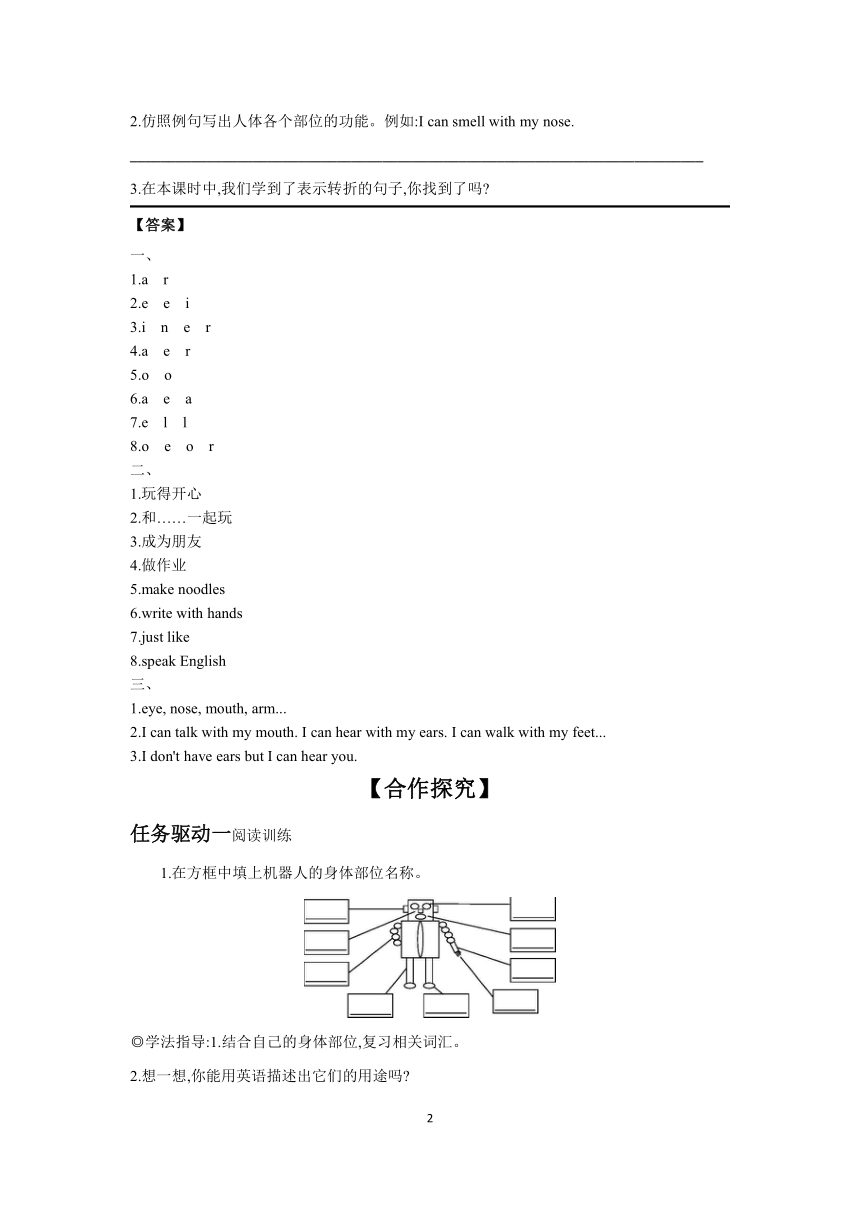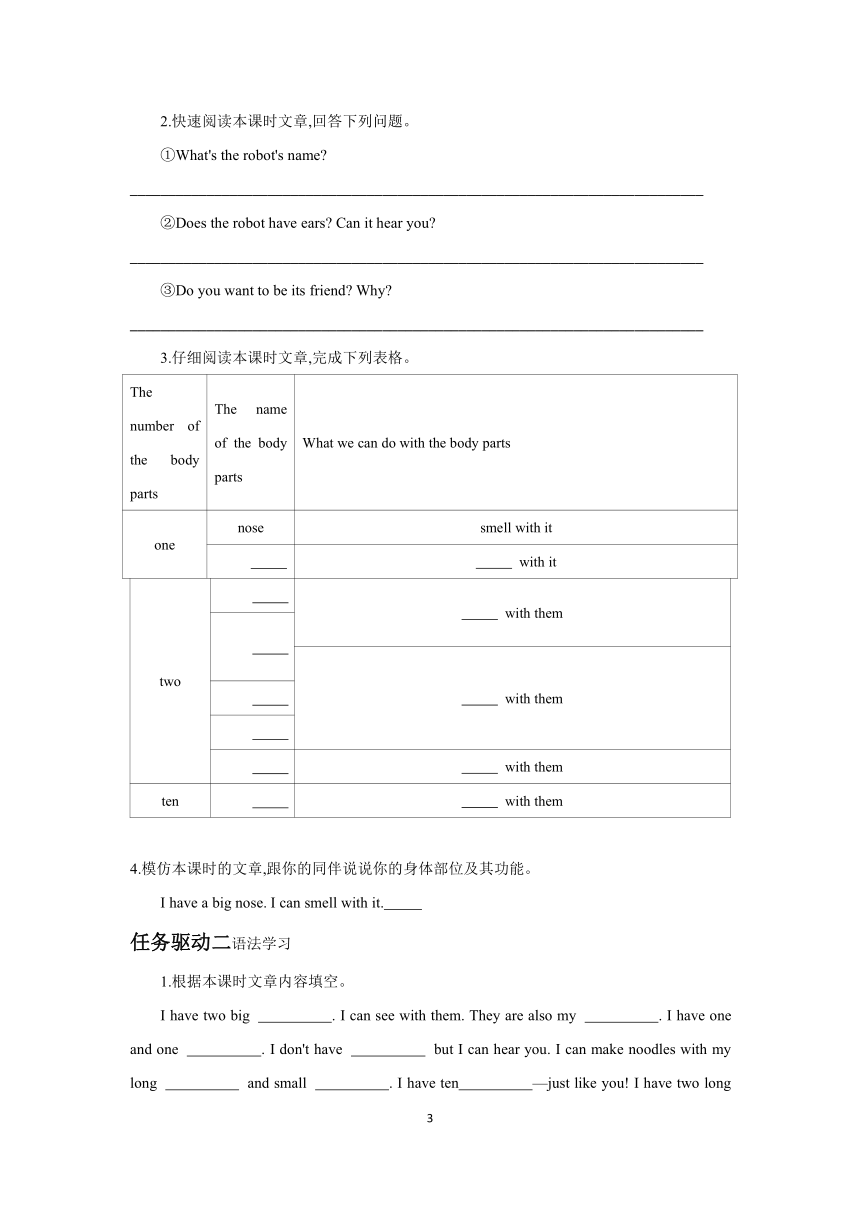冀教版七年级上册Unit 3 Lesson 13 Body Parts学案(含答案)
文档属性
| 名称 | 冀教版七年级上册Unit 3 Lesson 13 Body Parts学案(含答案) |  | |
| 格式 | docx | ||
| 文件大小 | 72.6KB | ||
| 资源类型 | 教案 | ||
| 版本资源 | 冀教版 | ||
| 科目 | 英语 | ||
| 更新时间 | 2024-02-29 11:47:22 | ||
图片预览



文档简介
Unit 3 Lesson 13 Body Parts.
【学习目标】
1.能记住并能正确运用下列单词:part, feeling, robot, camera, smell, finger, player, homework。
2.能用英语说出身体各部位的名称。
3.掌握动词have和has的用法并学会正确运用。
【预习导学】
一、写一写
1.部分n. p t
2.感觉;情感n. f l ng
3.手指 n. f g
4.运动员;比赛者 n. pl y
5.机器人 n. r b t
6.照相机 n. c m r
7.嗅;闻起来 v. sm
8.家庭作业n. h m w k
二、填一填
1.have fun
2.play with
3.be friends
4.do one's homework
5.做面条
6.用手写
7.就像
8.说英语
三、想一想
1.你能默写出我们身体各个部位的名称吗
___________________________________________________________________________
2.仿照例句写出人体各个部位的功能。例如:I can smell with my nose.
___________________________________________________________________________
3.在本课时中,我们学到了表示转折的句子,你找到了吗
【答案】
一、
1.a r
2.e e i
3.i n e r
4.a e r
5.o o
6.a e a
7.e l l
8.o e o r
二、
1.玩得开心
2.和……一起玩
3.成为朋友
4.做作业
5.make noodles
6.write with hands
7.just like
8.speak English
三、
1.eye, nose, mouth, arm...
2.I can talk with my mouth. I can hear with my ears. I can walk with my feet...
3.I don't have ears but I can hear you.
【合作探究】
任务驱动一阅读训练
1.在方框中填上机器人的身体部位名称。
◎学法指导:1.结合自己的身体部位,复习相关词汇。
2.想一想,你能用英语描述出它们的用途吗
2.快速阅读本课时文章,回答下列问题。
①What's the robot's name
___________________________________________________________________________
②Does the robot have ears Can it hear you
___________________________________________________________________________
③Do you want to be its friend Why
___________________________________________________________________________
3.仔细阅读本课时文章,完成下列表格。
The number of the body parts The name of the body parts What we can do with the body parts
one nose smell with it
with it
two with them
with them
with them
ten with them
4.模仿本课时的文章,跟你的同伴说说你的身体部位及其功能。
I have a big nose. I can smell with it.
任务驱动二语法学习
1.根据本课时文章内容填空。
I have two big . I can see with them. They are also my . I have one and one . I don't have but I can hear you. I can make noodles with my long and small . I have ten —just like you! I have two long and two big .We can be . I want to make friends with you.
◎学法指导:认真观察名词的复数形式变化,交流探讨其中的变化规则。
2.参考以上句子,观察表格中名词复数的变化,与同伴交流后写出变化规则。
单数形式 复数形式 变化规则
eye eyes
mouth mouths
box boxes
bus buses
watch watches
brush brushes
library libraries
child children
foot feet
3.小游戏:
每位同学准备一张卡片并写上一个可数名词的单数形式,反扣在桌子上。参赛的小组轮流派出一个成员抽取一张卡片,写出该名词的复数形式。写出正确答案最多的小组获胜。
【答案】
任务驱动一
1.
2.①Its name is Robin./Robin is its name.
②No, it doesn't. But it can hear us.
③Yes, I do. Because it is very cute./No, I don't. Because it doesn't have feelings.
3.
The number of the body parts The name of the body parts What we can do with the body parts
one nose smell with it
mouth talk with it
two eyes see with them
arms make noodles with them
hands
legs play football with them
feet
ten fingers write with them
4.I have a small mouth. I can speak English with it. Sure, I can also eat food with my mouth...
任务驱动二
1.eyes cameras nose mouth ears arms hands fingers legs feet friends
2.一般情况下,直接在词尾加-s
以s、x、sh或ch结尾的词,在词尾加-es
以辅音字母+y结尾的词,先把y变i,再加-es
部分单词的复数形式变化不规则,需要逐个记忆
【知识超市】
[命题点一]I have two big eyes. 我有两只大眼睛。
have作实义动词, 意为“有;拥有”,它的第三人称单数形式是has。强调某个东西归某人所有,也可用于某人的外貌特征,尤其是五官及头发。常用句型:某人+have/has +(a/an)形容词+名词。例如:
She has two big eyes. 她有两只大眼睛。
【拓展】其否定结构为:某人+don't/doesn't have+(a/an)形容词+名词。当主语是第三人称单数时,肯定句用has,否定句用doesn't have。
对点自测
用have或has填空。
1.I two sisters.They are very beautiful.
2.Tom and Jane a big house in the city.
3.Lily a pair of purple gloves.
4.He long legs and a small nose.
[命题点二]I can see with them. 我用它们看。
该句中的with用作介词,意为“用……”,表示方式, 在句中作状语,后常跟身体部位或者工具。
【拓展】with还可译为“和……一起”,表示伴随,在句中作状语。例如:
He often sleeps with the windows open.他常开着窗睡觉。
对点自测
单项选择。
( )1.Look! The boy can write his left hand.
A.to B.for C.with D.in
( )2.Tom can make a plane paper.
A.in B.for C.with D.to
( )3.Please come me!
A.for B.with C.to D.in
[命题点三]They are also my cameras.它们也是我的照相机。
also作副词,意为“也”,用于实义动词之前,系动词或助动词之后。同义词too 需放在句尾。例如:
I also get to school early every day. = I get to school early every day, too. 我也每天很早到校。
对点自测
单项选择。
( )1.He is an American student.
A.too B.also C.to D.either
( )2.I want to go shopping with you, .
A.too B.also C.to D.either
[命题点四]I can smell with my nose. 我能用鼻子闻。
smell意为“闻;嗅”。例如:
What can you smell 你能闻到什么
【拓展】
1.smell 还可作连系动词,意为“闻起来”,后接形容词作表语。例如:
The flowers smell good. 花闻起来很香。
2.smell还可以作名词,意为“气味”。例如:
What a nice smell! 多香的味道啊!
对点自测
根据汉语提示完成句子。
1.你能用鼻子闻一下吗
Can you your nose
2.那些玫瑰好闻极了。
Those roses good.
【答案】
命题点一
对点自测
1.have 2.have 3.has 4.has
命题点二
对点自测
1.C 2.C 3.B
命题点三
对点自测
1.B 2.A
命题点四
对点自测
1.smell with
2.smell
2
【学习目标】
1.能记住并能正确运用下列单词:part, feeling, robot, camera, smell, finger, player, homework。
2.能用英语说出身体各部位的名称。
3.掌握动词have和has的用法并学会正确运用。
【预习导学】
一、写一写
1.部分n. p t
2.感觉;情感n. f l ng
3.手指 n. f g
4.运动员;比赛者 n. pl y
5.机器人 n. r b t
6.照相机 n. c m r
7.嗅;闻起来 v. sm
8.家庭作业n. h m w k
二、填一填
1.have fun
2.play with
3.be friends
4.do one's homework
5.做面条
6.用手写
7.就像
8.说英语
三、想一想
1.你能默写出我们身体各个部位的名称吗
___________________________________________________________________________
2.仿照例句写出人体各个部位的功能。例如:I can smell with my nose.
___________________________________________________________________________
3.在本课时中,我们学到了表示转折的句子,你找到了吗
【答案】
一、
1.a r
2.e e i
3.i n e r
4.a e r
5.o o
6.a e a
7.e l l
8.o e o r
二、
1.玩得开心
2.和……一起玩
3.成为朋友
4.做作业
5.make noodles
6.write with hands
7.just like
8.speak English
三、
1.eye, nose, mouth, arm...
2.I can talk with my mouth. I can hear with my ears. I can walk with my feet...
3.I don't have ears but I can hear you.
【合作探究】
任务驱动一阅读训练
1.在方框中填上机器人的身体部位名称。
◎学法指导:1.结合自己的身体部位,复习相关词汇。
2.想一想,你能用英语描述出它们的用途吗
2.快速阅读本课时文章,回答下列问题。
①What's the robot's name
___________________________________________________________________________
②Does the robot have ears Can it hear you
___________________________________________________________________________
③Do you want to be its friend Why
___________________________________________________________________________
3.仔细阅读本课时文章,完成下列表格。
The number of the body parts The name of the body parts What we can do with the body parts
one nose smell with it
with it
two with them
with them
with them
ten with them
4.模仿本课时的文章,跟你的同伴说说你的身体部位及其功能。
I have a big nose. I can smell with it.
任务驱动二语法学习
1.根据本课时文章内容填空。
I have two big . I can see with them. They are also my . I have one and one . I don't have but I can hear you. I can make noodles with my long and small . I have ten —just like you! I have two long and two big .We can be . I want to make friends with you.
◎学法指导:认真观察名词的复数形式变化,交流探讨其中的变化规则。
2.参考以上句子,观察表格中名词复数的变化,与同伴交流后写出变化规则。
单数形式 复数形式 变化规则
eye eyes
mouth mouths
box boxes
bus buses
watch watches
brush brushes
library libraries
child children
foot feet
3.小游戏:
每位同学准备一张卡片并写上一个可数名词的单数形式,反扣在桌子上。参赛的小组轮流派出一个成员抽取一张卡片,写出该名词的复数形式。写出正确答案最多的小组获胜。
【答案】
任务驱动一
1.
2.①Its name is Robin./Robin is its name.
②No, it doesn't. But it can hear us.
③Yes, I do. Because it is very cute./No, I don't. Because it doesn't have feelings.
3.
The number of the body parts The name of the body parts What we can do with the body parts
one nose smell with it
mouth talk with it
two eyes see with them
arms make noodles with them
hands
legs play football with them
feet
ten fingers write with them
4.I have a small mouth. I can speak English with it. Sure, I can also eat food with my mouth...
任务驱动二
1.eyes cameras nose mouth ears arms hands fingers legs feet friends
2.一般情况下,直接在词尾加-s
以s、x、sh或ch结尾的词,在词尾加-es
以辅音字母+y结尾的词,先把y变i,再加-es
部分单词的复数形式变化不规则,需要逐个记忆
【知识超市】
[命题点一]I have two big eyes. 我有两只大眼睛。
have作实义动词, 意为“有;拥有”,它的第三人称单数形式是has。强调某个东西归某人所有,也可用于某人的外貌特征,尤其是五官及头发。常用句型:某人+have/has +(a/an)形容词+名词。例如:
She has two big eyes. 她有两只大眼睛。
【拓展】其否定结构为:某人+don't/doesn't have+(a/an)形容词+名词。当主语是第三人称单数时,肯定句用has,否定句用doesn't have。
对点自测
用have或has填空。
1.I two sisters.They are very beautiful.
2.Tom and Jane a big house in the city.
3.Lily a pair of purple gloves.
4.He long legs and a small nose.
[命题点二]I can see with them. 我用它们看。
该句中的with用作介词,意为“用……”,表示方式, 在句中作状语,后常跟身体部位或者工具。
【拓展】with还可译为“和……一起”,表示伴随,在句中作状语。例如:
He often sleeps with the windows open.他常开着窗睡觉。
对点自测
单项选择。
( )1.Look! The boy can write his left hand.
A.to B.for C.with D.in
( )2.Tom can make a plane paper.
A.in B.for C.with D.to
( )3.Please come me!
A.for B.with C.to D.in
[命题点三]They are also my cameras.它们也是我的照相机。
also作副词,意为“也”,用于实义动词之前,系动词或助动词之后。同义词too 需放在句尾。例如:
I also get to school early every day. = I get to school early every day, too. 我也每天很早到校。
对点自测
单项选择。
( )1.He is an American student.
A.too B.also C.to D.either
( )2.I want to go shopping with you, .
A.too B.also C.to D.either
[命题点四]I can smell with my nose. 我能用鼻子闻。
smell意为“闻;嗅”。例如:
What can you smell 你能闻到什么
【拓展】
1.smell 还可作连系动词,意为“闻起来”,后接形容词作表语。例如:
The flowers smell good. 花闻起来很香。
2.smell还可以作名词,意为“气味”。例如:
What a nice smell! 多香的味道啊!
对点自测
根据汉语提示完成句子。
1.你能用鼻子闻一下吗
Can you your nose
2.那些玫瑰好闻极了。
Those roses good.
【答案】
命题点一
对点自测
1.have 2.have 3.has 4.has
命题点二
对点自测
1.C 2.C 3.B
命题点三
对点自测
1.B 2.A
命题点四
对点自测
1.smell with
2.smell
2
同课章节目录
- Unit 1 School and friends
- Lesson 1 Hello!
- Lesson 2 Teacher and Students
- Lesson 3 Welcome to Our School
- Lesson 4 What Is It?
- Lesson 5 May I Have a Book?
- Lesson 6 Things for School
- Unit 2 Colours and Clothes
- Lesson 7 Jenny's New Skirt
- Lesson 8 Danny's Favourit Colou
- Lesson 9 Whose Coat Is This?
- Lesson 10 Clothes for a Cold Day
- Lesson 11 Clothes around the World
- Lesson 12 Let's Go Shopping!
- Unit 3 Body Parts and Feelings
- Lesson 13 Body Parts
- Lesson 14 Colours and Feelings
- Lesson 15 Tall or Short
- Lesson 16 Happy or Sad
- Lesson 17 Seeing a Docto
- Lesson 18 We All Look Different!
- Unit 4 Food and Restaurants
- Lesson 19 Time for Breakfast!
- Lesson 20 I Like the Supermarket!
- Lesson 21 At the Market
- Lesson 22 In the Restaurant
- Lesson 23 The Corner Store
- Lesson 24 Eat Good Food!
- Unit 5 Family and Home
- Lesson 25 Jenny's Family
- Lesson 26 Li Ming's Family
- Lesson 27 Danny at Home
- Lesson 28 A Family Picnic
- Lesson 29 A Birthday Card
- Lesson 30 Grandma's Birthday Party
- Unit 6 Let's Go!
- Lesson 31 Let's Go to the Bookstore!
- Lesson 32 At the Supermarket
- Lesson 33 Let's Go to the Zoo!
- Lesson 34 On the Farm
- Lesson 35 Let's Go to the Museum!
- Lesson 36 Let's Go to the Movie Theatre!
- Unit 7 Days and Months
- Lesson 37 Seasons and Weathe
- Lesson 38 Nick's Busy Month
- Lesson 39 A Class Calenda
- Lesson 40 When Is Your Birthday?
- Lesson 41 Holidays
- Lesson 42 Happy Holidays!
- Unit 8 Countries around the world
- Lesson 43 Directions
- Lesson 44 Jack's Goodbye Party
- Lesson 45 China
- Lesson 46 Canada and the U.S.
- Lesson 47 The U.K. and Australia
- Lesson 48 English-Speaking Countries
